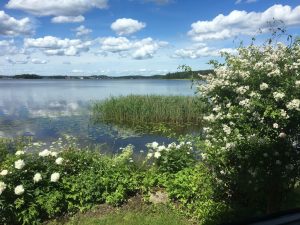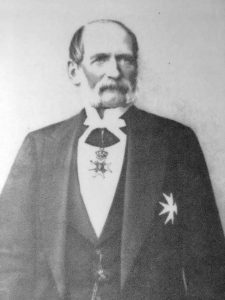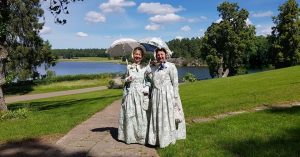Elisabeth Schwan at Stjernsund
Look, do you think these are Elisabeth Schwan’s? I ask Kerstin.
On a small round table, some beautiful antique fans are displayed under glass.
Kerstin and I are visiting Stjernsund’s Castle where Augusta’s friend, Elisabeth, lived after she and her husband bought the beautiful castle from the royal family in 1860. I wrote about her earlier this year (The Girl in the Yellow Ball Gown: Elisabeth Schwan).
We are on a guided tour of the castle, eagerly looking for traces of Elisabeth. Much of the inventory would have belonged to Elisabeth’s and Knut’s daughter-in-law, who lived in the castle until her death in 1951. But maybe there would be a few things left from Elisabeth?
And now it looks like I have found something that could have been hers. Our wonderful tour guide, Pernilla, confirms that this is indeed Elisabeth’s. Another similar table has some old letters addressed to Elisabeth. Elisabeth also brought all her copper pots and pans with her when they moved to Stjernsund – all hanging nicely in the kitchen, sorted according to size.
Using the language of Augusta’s time, Stjernsund is handsomely situated on a promontory above the still, blue waters of lake Alsen. Here, Elisabeth and Knut raised 5 sons, born between 1851 and 1861.
I wonder if she kept a diary? Did she miss the social life in Stockholm? Did her friends from Stockholm come and visit her?

The Amaranth Ball, 6 January 1845. Painting by Fritz von Dardel. Elisabeth Schwan is the girl in the yellow ballgown. She was 17 years old.
While Elisabeth was busy with her family, her husband made Stjernsund famous for its cattle. Knut Cassel was interested in animal breeding and through selection of superior breeding stock, the herd at Stjernsund came to be the most influential genetic stock for what is now the Swedish Red-and-White Breed of dairy cattle (SRB).
Kerstin and I visit the exhibition in the Dairy. There are two photographs on the wall, one of Elisabeth and Knut with their 3 oldest sons (Fredrik b. 1851, Carl b. 1853, and Knut August b. 1855) and another one of Knut later in life. As their 4th son, Albert, was born in August of 1857, and Elisabeth is having a 2-year-old Knut August on her lap, the picture must have been taken around 1856-1857, prior to the family moving to Stjernsund. Elisabeth would have been in her late 20s in the picture and possibly pregnant with Albert.
Finally, while doing the genealogy research on Knut Cassel, I discover that he and Augusta were 4th degree cousins (through Augusta’s father’s ancestry).
As Kerstin and I always do on our “Augusta journeys”, we dressed appropriately for a visit in the early 1850s. Our new friend and Stjernsund’s guide, Pernilla Gäverth, captured our visit in the following pictures.
About SRB cattle (in Swedish): http://www.scanred.se/hist02sv.html









[…] Elisabeth Schwan at Stjernsund […]